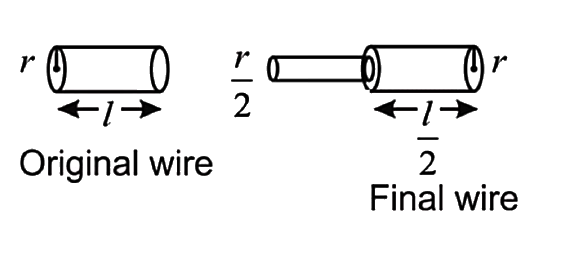A wire of lenth L is drawn such that its diameter is reduced to half of its original diamter. If the initial resistance of the wire were 10Ω, its new resistance would be
40Ω
80Ω
160Ω
120Ω
The correct Answer is:C
To find the new resistance of the wire after its diameter is reduced to half of its original diameter, we can follow these steps:
Step 1: Understand the relationship between resistance, length, and area
The resistance R of a wire is given by the formula:
R=ρLA
where ρ is the resistivity of the material, L is the length of the wire, and A is the cross-sectional area.
Step 2: Determine the initial resistance
We are given that the initial resistance R is 10Ω.
Step 3: Analyze the change in diameter
If the original diameter of the wire is D, then the new diameter after being drawn is:
d=D2
Step 4: Calculate the initial and new areas
The cross-sectional area A of the wire is given by:
A=πD24
For the new diameter d:
A′=π(d)24=π(D2)24=πD216
Step 5: Relate the volumes before and after drawing the wire
Since the volume of the wire remains constant, we have:
V=A⋅L=A′⋅L′
Substituting the areas:
πD24⋅L=πD216⋅L′
Cancelling πD2 from both sides:
L4=L′16
This simplifies to:
L′=4L
Step 6: Substitute the new length and area back into the resistance formula
Now substituting L′ and A′ into the resistance formula for the new resistance R′:
R′=ρL′A′=ρ(4L)(πD216)=4ρLπD216=4⋅16ρLπD2=64⋅ρLA
Since R=ρLA=10Ω:
R′=64⋅10=640Ω
Step 7: Conclusion
Thus, the new resistance of the wire after it is drawn to half its original diameter is:
640Ω
The resistance R of a wire is given by the formula:
R=ρLA
where ρ is the resistivity of the material, L is the length of the wire, and A is the cross-sectional area.
We are given that the initial resistance R is 10Ω.
If the original diameter of the wire is D, then the new diameter after being drawn is:
d=D2
The cross-sectional area A of the wire is given by:
A=πD24
For the new diameter d:
A′=π(d)24=π(D2)24=πD216
Since the volume of the wire remains constant, we have:
V=A⋅L=A′⋅L′
Substituting the areas:
πD24⋅L=πD216⋅L′
Cancelling πD2 from both sides:
L4=L′16
This simplifies to:
L′=4L
Now substituting L′ and A′ into the resistance formula for the new resistance R′:
R′=ρL′A′=ρ(4L)(πD216)=4ρLπD216=4⋅16ρLπD2=64⋅ρLA
Since R=ρLA=10Ω:
R′=64⋅10=640Ω
Thus, the new resistance of the wire after it is drawn to half its original diameter is:
640Ω
Topper's Solved these Questions
- CURRENT ELECTRICITYBook:A2ZChapter:CURRENT ELECTRICITYExercise:Assertion- Reason
Explore 14 Videos
- CURRENT ELECTRICITYBook:A2ZChapter:CURRENT ELECTRICITYExercise:Section D - Chapter End Test
Explore 29 Videos
- CURRENT ELECTRICITYBook:A2ZChapter:CURRENT ELECTRICITYExercise:Section - C
Explore 1 Video
- ATOMIC PHYSICSBook:A2ZChapter:ATOMIC PHYSICSExercise:Section D - Chapter End Test
Explore 30 Videos
- DUAL NATURE OF RADIATION AND MATTERBook:A2ZChapter:DUAL NATURE OF RADIATION AND MATTERExercise:Section D - Chapter End Test
Explore 30 Videos
Similar Questions
A wire of length l has a resistance R. If half of the length is stretched to make the radius half of its original value, then the final resistance of the wire is

View SolutionA piece of wire of resistance 20Ω is drawn out so that its length is increased to twice its original length. Calculate the resistance of the wire in the new situation.
View Solution
Knowledge Check
A wire of lenth L is drawn such that its diameter is reduced to half of its original diamter. If the initial resistance of the wire were 10Ω, its new resistance would be
A40ΩB80ΩC120ΩD160ΩA wire of length l is drawn such that its diameter is reduced to half of its original diameler. If the initial resistance of the wire were 10Ω. its resistance would become
A40ΩB60ΩC120ΩD160ΩThe diameter of aluminium wire is reduced to half its original value, then its resistance will become
Afour timesBtwo timesCeight timesDsixteen times
A wire of resistance 18 ohm is drawn until its radius reduce 12th of its original radius then resistance of the wire is
View SolutionA wire of resistance 18 ohm is drawn until its radius reduce 12th of its original radius then resistance of the wire is
View SolutionIf a wire of resistance R is melted and recasted in to half of its length, then the new resistance of the wire will be
View SolutionIf a wire of resistance R is melted and recasted to half of its length, then the new resistance of the wire will be
View SolutionA wire has a resistance of 32Ω. It is melted and drawn into a wire of half of its original length. What is the resistance of the new wire?
View Solution
